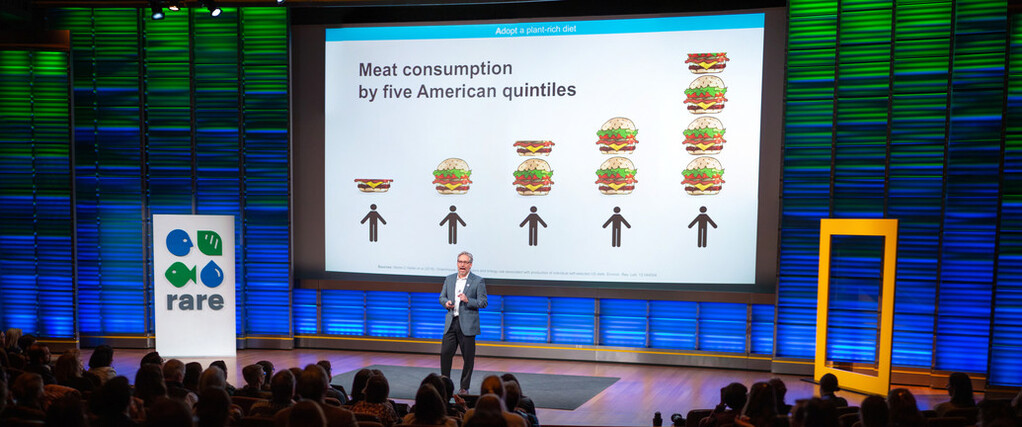Most people just don’t hear enough about climate change. For example, 66% of Americans hear about climate change in the media once a month or even less (explore the data here). In countries around the world, most people say they need more information about climate change. The more often people hear about climate, and the more diverse the trusted sources they hear it from, the stronger the message becomes. Climate change doesn’t just belong within the narrow band of climate journalism, nature documentaries, or environmental non-profits. Novels, music, movies, television, radio, advertising, community leaders, social media influencers play a role.
Rare, the Behavioural Insights Team, and Potential Energy Coalition have created a new resource outlining eight principles for effective and inviting climate communication. These science-based principles are easily digestible, yet specific enough to improve the effectiveness of what you’re aiming to convey.

Make it personal

Make it about people, not the planet. Forget the distant ice sheets, focus on what matters to people—their homes, families, livelihoods, communities, favorite forests, beaches or animals. Bring the distant, long-term and abstract to here, now and concrete. Connect the dots and show people tangibly how they and their families are experiencing climate impacts already (most “natural disasters” are turbo-charged by climate change). Use frames that work well, including highlighting personal benefits: health, cost savings and cool tech like EVs or solar. Focusing on local impacts with the right characteristics (flooding, high air-conditioning bills, days your kids can’t play outside) can be particularly effective at motivating action.

Make it accessible

Nobody wakes up in the morning saying, “what a great day for some decarbonization.” It’s helpful to use commonplace frames and terms that get people’s attention: overheating more than global warming, extreme weather more than changing climate, air pollution more than emissions. For example, phrases like carbon neutral and mitigation are not easily understood when tested with Americans. Simple, clear messages, repeated often, overcome the language barriers of climate science, so use language that is plain, obvious, and universal. All audiences react to concepts they already understand, which is why messages about pollution, fairness, and accountability are shown to increase support for action. Describing climate change as being caused by “the manmade blanket of carbon dioxide that is building up around the Earth and trapping in heat” has been shown to be a highly effective frame.
Key to making it accessible is finding creative ways to talk about the issue, bring a new spin, take a new angle. Tell a story to make it understandable, interesting, and engaging. Try humor or satire (e.g., Florida man is endangered!) but still treat the issue seriously. Avoid relying on cold jargon and numbers—temperature and policy references will cause people to disengage (and yawn). More conservative audiences prefer framing of ‘clean and healthy air,’ ‘protecting family and community,’ ‘protecting nature,’ ‘job creation,’ ‘national security,’ and ‘faith and stewardship.’

Make it empowering

Direct emotions towards solutions. Emotions like anger, hope, amusement and pride, if harnessed constructively, can empower people to face the climate crisis. Most news and mainstream media today is doom and gloom without offering up solutions. Insights from psychology and the social sciences have shown that this narrative can make people feel anxious, stressed, fearful or guilty which, most often, turns people off or disempowers them. Acknowledge the severity and urgency of the issue but don’t harp on it too much (many are already deeply alarmed and experiencing mental health challenges). Focus instead on helping people imagine an optimistic path forward by showing them solutions. This is not about sugar coating. Instead, it is about painting a complete story (challenge plus solutions) that connects emotions to action.

Make it doable

A key part of making it doable is to give people agency. People with higher self-efficacy (the belief in one’s capacity to take action) or response efficacy (the belief that one’s actions make a difference) are more likely than those with low-efficacy (e.g., those who believe nothing can be done) to take climate action. To build efficacy through communication, point people towards high-impact climate actions they can take as individuals and as part of their communities. That said, don’t ask everyone to become an activist right away. A meat-lover is unlikely to become a vegan, cold turkey (pun intended). Meet people where they are and help them take gradual steps.

Make it collective

The best science indicates that this is an “all solutions on deck” moment, where collaboration at all levels of society is required; from individuals to governments (a good explainer here). Individuals can be part of the solution but must not be blamed for the problem as this causes unnecessary guilt, shame, or embarrassment. Rather, people must see themselves as part of a larger group taking action that, collectively, can make a difference.

Make it normal

Social science shows that people are more likely to engage in climate-friendly behaviors, at home and while traveling, when they think a behavior is “socially normal.” To make a climate-friendly behavior feel socially normal, give examples of people already engaged in the behavior, show that more and more people are engaging in the behavior and demonstrate that society wants people to engage in the behavior. Doing this is important because people often underestimate how common climate-friendly behaviors have become. Note, this is also why sharing unfavorable stats (e.g., less than 1% of people have joined a climate action group) does more harm than good as it signals that climate-friendly behaviors are uncommon and, therefore, not the norm.

Make it trustworthy

Choose messengers wisely. Bring in trusted, beloved, relatable and diverse messengers so people can see themselves as part of the movement. The most impactful climate communications come from “people like me,” who are affected and care. Messengers are especially effective when they ‘walk the talk.‘ Note that climate scientists and immediate family members (including children!) are regarded as the most trusted messengers on climate. This means that any other messengers (e.g., celebrities, athletes, influencers) used in climate content should be in a listening, learning or modeling role rather than an expert role, and that one’s family members have a surprisingly strong influence.

Make it for everyone

To engage all audiences in climate, focus on commonalities instead of differences. That means not giving the debate an unnecessary spotlight. Referencing denial arguments, even to shoot them down, can give the arguments an unnecessary spotlight when 99.9% of scientists agree on climate science and >70% of people globally want to see climate action. If it’s necessary to mention climate misinformation, do so by preemptively warning that only a small % of people believe it, and only a small number of actors (e.g., the Carbon Majors) perpetuate it.

